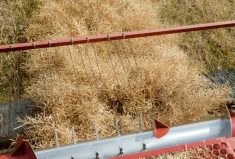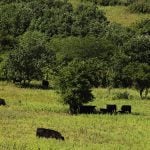Western Canadian feeder cattle prices were $3 to $4 per hundredweight (cwt) higher on average. Cattle buyers were scrambling to fill orders on yearlings as supply uncertainty continues to drive prices higher.
Feedlot vacancy is at seasonal lows and operators want to fill pens as soon as possible. Feeding margins are narrowing with higher replacement costs but the feeder vmarket continues to have momentum to the upside.
Features this week included a small string of thin-fleshed 800-pound Angus-based steers traded at $245/cwt in central Alberta. U.S. buyers were more aggressive in Manitoba due to stronger feeding margins in the U.S. It appears that burdensome corn crop is enhancing the competitive advantage south of the border.
Read Also

U.S. grains: Soybean prices rise as China-U.S. truce assessed
Chicago soybean prices rose on Wednesday, recovering some of the previous session’s losses, as Beijing’s confirmation that it was cutting tariffs on U.S. farm goods put attention back on a trade truce between the countries.
Calf prices were rather volatile, depending on location and quality. Feedlots are not afraid of weaned vaccinated calves but they don’t want to contend with potential sick bawlers this early in the season. Exotic vaccinated 500-lb. calves were trading for $290/cwt in southern Alberta. The farmer/backgrounding operator will likely step forward later in September when harvest is completed. Once yearling supplies dry up and combines are in the shed, calf values should even out across Western Canada.
Wholesale beef prices have been softening; however, Alberta packers were buying fed cattle at $162/cwt, similar to seven days earlier. Retail and restaurant demand tends to deteriorate in September, but this hasn’t trickled through to the feeder market.
U.S. feeder prices continue to lead the Canadian market higher, and the weaker feed grain complex will be the main supportive factor moving forward. The upside in the fed market appears to be defined for the time being, with packing margins coming under pressure. U.S. dressed carcass weights are 18 lbs. above year-ago levels, so beef production in the fourth quarter may be larger than earlier anticipated. Look for feeder cattle prices to stay firm to slightly higher over the next couple of weeks. Barley, corn and feed wheat prices have further downside potential.
– Jerry Klassen is a commodity market analyst in Winnipeg and maintains an interest in the family feedlot in southern Alberta. He writes an in-depth biweekly commentary, Canadian Feedlot and Cattle Market Analysis, for feedlot operators in Canada. He can be reached by email at [email protected] for questions or comments.











